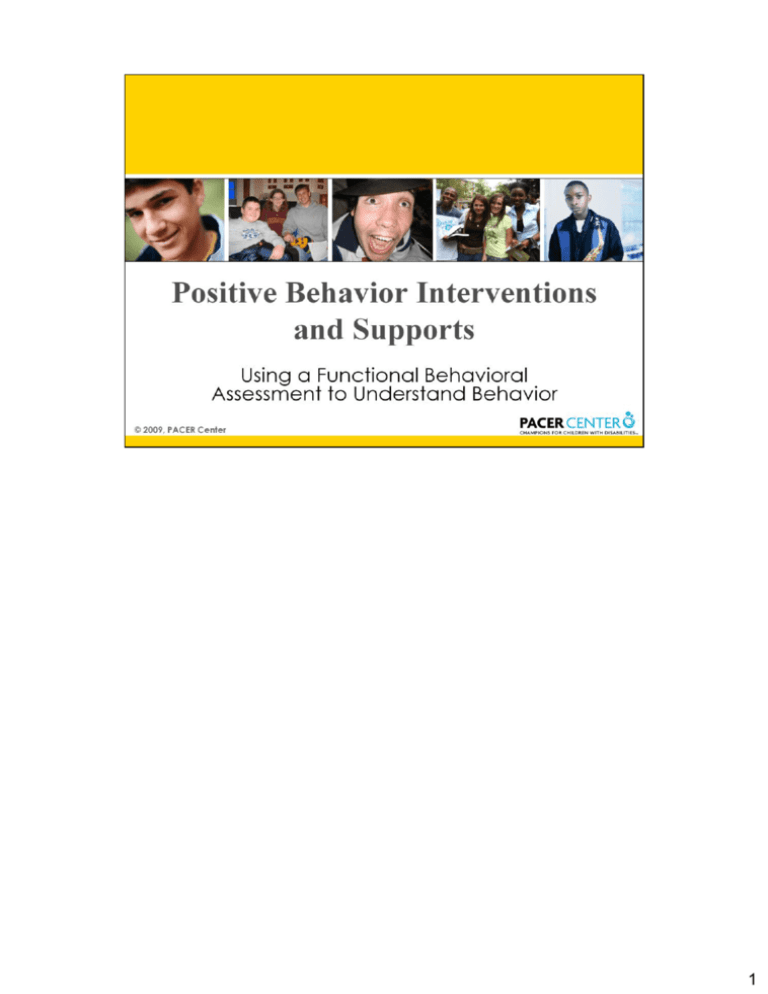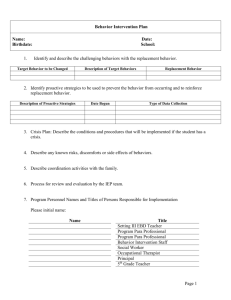In My Own Words: This is Who I Am!
advertisement

1 2 Everyone uses behavior as a form of communication. Babies cry to let their caregiver know they are hungry, wet, or need attention. Toddlers may throw a toy to get attention. Older children may swear when frustrated, and a teenager may slam a door to communicate their displeasure at being “grounded”. All these forms of behavior clearly communicate a need. Some behavior however, may result from a physiological function, such as the tics associated with Tourette Disorder or obsessive behaviors related to Obsessive-Compulsive Disorder. Those behaviors create challenges as they do not serve a function that is understood. They are known as “nonpurposeful” behaviors, and do not appear to have a meaning as do other kinds of behaviors. There are also behaviors that may result from frustration, anxiety, depression or anger about a need that has not been met. For example, a poor reader may become disruptive in class for fear of being called on to read out loud. This student wants to be sent out of class to avoid looking stupid. Or a child who feels overwhelmed by homework may shut down and refuse to do it. While parents may see the refusal as disobedience, the child may simply be trying to manage anxiety about not understanding the assignment, Behavior of this type is called “purposeful” 3 Because behavior can originate from many different sources, it is our responsibility as parents to try to understand why the behavior is happening. While some parents may need help from school staff or other professionals to discover the reasons for a child’s behavior, all parents can recognize when they need a new strategy to address their child’s behavior. If parents are frustrated because repeated punishment does not change their child’s behavior, that signals a need for a different strategy. If problem behavior does not change despite negative consequences, then we must assume that the punishment is not addressing the problem. It is just managing the symptom. The challenge for parents is to find new ways of understanding the interactions between a child and his or her environment so a plan can be developed that leads to lasting behavior change. Using a Functional Behavioral Assessment can help uncover the logic behind your child’s behavior and point the way to positive change. 4 Functional behavioral assessment is a process for collecting information to determine the possible cause of problem behaviors and to identify strategies to address the behaviors. This process is frequently used at school for a child on an Individualized Education Program, but any parent can make use of this process. School personnel do a functional behavioral assessment when a child does not respond to the typical methods used to change problem behavior. They may use several strategies to discover a reason for the child’s behavior, including interviewing the child and his or her parents and classmates; observing the child in different environments such as at lunch, on the playground and in the classroom; gathering reports from teachers and other professionals and reviewing records. At home, parents can do their own functional behavior assessment using many of the same strategies. When collecting information about the possible cause of your child’s problem behavior, it is also important to consider your child’s personality and temperament, medical conditions and behaviors associated with the condition, and the effects of any medications your child is taking. For instance, a child diagnosed with bipolar disorder may experience increased periods of stress due to changes in medications. Another child, as a result of an undetected allergy, sleep deprivation, or a negative experience with peers may also have increased behaviors. When it’s completed, a functional behavioral assessment should provide an educated guess about how your child’s environment contributes to his or her positive and problem behaviors. It should also provide the basis for development of a proactive plan that is focused on interventions and teaching new skills. 5 A Functional Behavior Assessment can be explained using a 7 step process. It is important to remember, however, that these steps may vary with the individual needs of each child. First, it is important to focus on the one or two behaviors that are the most serious, and to define the behaviors in terms that everyone understands. For example, saying that Sean’s problem behavior is disruptive is not specific enough. Saying that Sean’s problem behavior is blurting out and speaking out of turn is more descriptive. Parents can understand their child’s need for the behavior by determining where the behavior occurs and does not occur and identifying what happens before the behavior occurs. Pinpointing other factors relating to the environment help as well. Gathering information from as many sources as possible also helps identify any patterns related to the problem behavior. Parents can question their child, other family members, classroom teachers and school staff, as well as other people involved in their child’s day. 6 It is also important to understand the payoff for the behavior. If your child continues to use the problem behavior even after being redirected or punished, then the behavior is enough to meet the child’s needs. It works so your child has no reason to change. Using the information collected about your child, tracking where the behavior occurs, and seeing what your child gets as a result of using the behavior helps you to form an educated guess about WHY the problem behavior is occurring. Once you recognize the reason or function of the behavior, you can help your child develop replacement behaviors that serve the same function and meet your child’s needs. For example, if Sean is being disruptive at home by inappropriately interrupting at dinner time, and continues to do so despite redirection, you may end up sending him to his room. This may be exactly what your child wants. He may be using the behavior to get out of eating his vegetables, or having to do the dishes. Once parents can determine why the behavior happens, you can be proactive and anticipate the problem behavior by offering a favorite sauce with the undesired vegetable, or offering incentives to do the dishes. These are called positive behavior interventions. 7 A positive behavior intervention plan uses the information from the functional behavioral assessment and focuses on teaching or reinforcing appropriate behavior skills. There are several characteristics of a proactive plan. One characteristic is making changes in the environment to help reduce or eliminate the inappropriate behaviors. This means noticing how the setting influences your child’s problem behavior, and making changes so that they will NOT have a negative impact from their environment. For example, a child who is easily distracted may need to have a quiet out of the way place to do homework. Another characteristic of a proactive plan is replacing the problem behavior with appropriate behavior that serves the same purpose. This may mean giving your child direct instruction in using a more positive strategy to get a need met. For example, a child who has poor social skills may knock off the hat of another child to get attention instead of using age-appropriate language. Teaching this child actual language skills, modeling them and encouraging their use in everyday events gives that child a new way to get attention. 8 It is very important to remember however, that children need support to change their behavior. At home and at school, we need to reinforce appropriate behavior . “Catch” your child doing the right thing! Research tells us that changing behavior takes time, reinforcement and re-teaching, so don’t give up! Remember, some children respond quickly to instruction and positive reinforcement while others take more time, more instruction and more reinforcement. Each child is unique. For a child with a disability, teaching a new skill, a new strategy and a new behavior may take more time and persistence. For any child, being consistent, supportive and positive is key. 9 If your child is NOT responding to the instruction and reinforcement you are using, then it is not meeting your child’s needs. It may be necessary to review the information you gathered and see if anything else can be added or if anything has changed. Remember, behavior will not change unless there is an equal payoff. 10 Everyone wants their child to have good behavior. When problem behavior occurs, and a child does not respond to typical interventions, we tend to believe that the child “is” the problem. Instead, think of it as the child is “having” a problem. In place of responding with punishment, think about instruction. What kind of behavior do I want to see? Do I model the kind of behavior I expect? Have I made the effort to teach my child a different behavior that will meet his or her needs? Do I reinforce the appropriate behavior when I see it? Every parent can make use of the strategies involved in a functional behavioral assessment and a positive intervention plan. If your child has problem behaviors and a disability, the Individualized Education Program should contain goals that teach new behaviors and a positive behavior intervention plan that supports and reinforces the new behaviors. If your child does not have a disability, but has a problem behavior, you can work at home and with school staff to assess the situation and create a positive, proactive plan also. Once we discover why children behave in certain ways, we can teach them new, positive behaviors that meet their needs. Helping your child learn appropriate behavior skills will contribute to better conduct at home, school and in the community. 11







